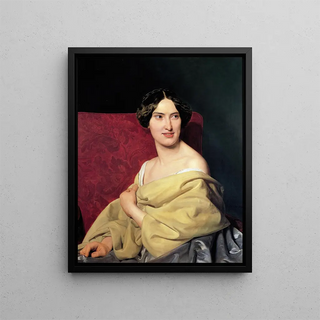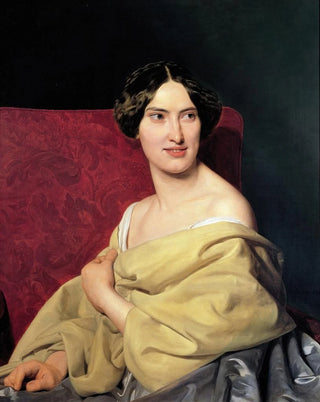Painting Anna Bayer, the artist's second wife - Ferdinand Georg Waldmüller | Art print


View from behind

Frame (optional)
Anna Bayer Art print, the artist's second wife - Ferdinand Georg Waldmüller – Engaging introduction
In the delicate world of 19th-century painting, some works stand out for their ability to capture not only appearance but also the essence of their subjects. "Anna Bayer, the artist's second wife - Ferdinand Georg Waldmüller" is one such piece. This vibrant portrait, evoking palpable intimacy, immerses us in Waldmüller's personal universe, an artist whose talent transcended the conventions of his time. Through this work, the artist immortalizes not only the image of his muse but also a moment of tenderness and complicity, offering viewers a glimpse into their relationship.
Style and uniqueness of the work
Ferdinand Georg Waldmüller's style is characterized by a realistic approach and meticulous attention to detail. In this portrait, the brightness of the colors and the softness of Anna Bayer's features testify to his artistic genius. The subtle use of light creates a warm atmosphere, while the delicate nuances of the model's skin add an almost tactile dimension to the piece. Every element, from clothing choices to accessories, is carefully thought out to reflect not only the beauty of the depicted woman but also her status and character. Waldmüller thus manages to transcend the simple portrait to offer a true psychological study, where the facial expression and posture of Anna reveal a complex and profound personality.
The artist and his influence
Ferdinand Georg Waldmüller, born in 1793 in Vienna, is often regarded as one of the pioneers of realism in painting. His career, marked by a desire for authenticity and truth, profoundly influenced his contemporaries and future generations. Waldmüller moves away from classical ideals to embrace a more intimate and personal vision of everyday life. His work is imbued with a sensitivity that allows him to capture fleeting moments with rare intensity. By choosing to paint his second wife, he does not merely depict a female figure but immortalizes an emotional bond, a love story that resonates through time. This humanist approach paved the way for many

Matte finish

View from behind

Frame (optional)
Anna Bayer Art print, the artist's second wife - Ferdinand Georg Waldmüller – Engaging introduction
In the delicate world of 19th-century painting, some works stand out for their ability to capture not only appearance but also the essence of their subjects. "Anna Bayer, the artist's second wife - Ferdinand Georg Waldmüller" is one such piece. This vibrant portrait, evoking palpable intimacy, immerses us in Waldmüller's personal universe, an artist whose talent transcended the conventions of his time. Through this work, the artist immortalizes not only the image of his muse but also a moment of tenderness and complicity, offering viewers a glimpse into their relationship.
Style and uniqueness of the work
Ferdinand Georg Waldmüller's style is characterized by a realistic approach and meticulous attention to detail. In this portrait, the brightness of the colors and the softness of Anna Bayer's features testify to his artistic genius. The subtle use of light creates a warm atmosphere, while the delicate nuances of the model's skin add an almost tactile dimension to the piece. Every element, from clothing choices to accessories, is carefully thought out to reflect not only the beauty of the depicted woman but also her status and character. Waldmüller thus manages to transcend the simple portrait to offer a true psychological study, where the facial expression and posture of Anna reveal a complex and profound personality.
The artist and his influence
Ferdinand Georg Waldmüller, born in 1793 in Vienna, is often regarded as one of the pioneers of realism in painting. His career, marked by a desire for authenticity and truth, profoundly influenced his contemporaries and future generations. Waldmüller moves away from classical ideals to embrace a more intimate and personal vision of everyday life. His work is imbued with a sensitivity that allows him to capture fleeting moments with rare intensity. By choosing to paint his second wife, he does not merely depict a female figure but immortalizes an emotional bond, a love story that resonates through time. This humanist approach paved the way for many
12,34 €






